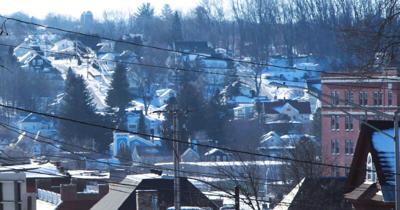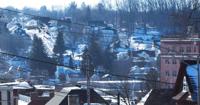The blizzard of March 1888 disrupted the lives of people in Montgomery County along with the rest of the northeastern United States.
The storm killed more than 400 people, including 200 schoolchildren and 100 sailors. Sustained high winds and temperatures well below freezing heightened the storm’s fury.
The blizzard disrupted the funeral services of Mrs. Robert Hartley in West Galway and West Charlton near Amsterdam.
In 1860, Amsterdam woodworker Isaac Shuler had opened a wood shop to make cabinets and furniture. Soon, Shuler was making coffins, and after the Civil War began offering undertaking services.
After Shuler died, W. Max Reid operated the undertaking business. Reid wrote a 1901 history book, “The Mohawk Valley.”
According to a newspaper accounts, Mrs. Hartley’s funeral service was held at the Presbyterian Church in West Galway as the blizzard raged on Monday, March 12, 1888. H.O. Wilkie was the undertaker for the Shuler funeral home.
Wilkie had 26 men with him who opened the roads as a procession set out for the West Charlton cemetery. They traveled two miles — reaching the farm of John Cunning — but could go no farther. The corpse was left at the Cunning farm.
Snow was said to be as high as the backs of the horses as Wilkie and the driver of the team pulling the hearse, Wells Johnson, trekked toward Amsterdam.
Johnson walked ahead of the team to find the road. Wilkie was thrown from the seat of the hearse several times when they hit potholes. The trip took four hours. Several mourners were stranded for several days at the West Galway church.
Burtiss Deal — born in 1882 in Amsterdam — was living with his parents in West Galway in 1888. His father operated a textile mill there.
The snowstorm and the birth of Deal’s younger brother Howard occurred simultaneously. The doctor was marooned with the Deals for several days. Deal was elected mayor of Amsterdam in 1947 and served four, two-year terms.
The 1888 storm dealt a heavy blow to the railroads. A cattle train was stalled between Amsterdam and Tribes Hill. Dead cattle had to be removed from the cars. Passenger and freight trains were stalled in Amsterdam on the north and south sides of the Mohawk River.
Conductor Mason of train 52 on the south side of the river had a big crew and, according to a published account, “Attended to the wants and comforts of his passengers in first class style. The jovial conductor had each foot incased in a canvas bag and presented a comical sight walking around in his improvised snow shoes.”
One reporter wrote, “Mrs. Cole, the New York Central ticket agent, was besieged with questions from belated travelers, but answered every one with a kind word and a smile.”
The wind was described as being “almost a cyclone at times.” As far as the eye could see, there was four feet of snow.
Charles Yund, a saloon keeper on Amsterdam’s South Side, stuck a large flag in a snow pile which completely covered one of his entrances. A reporter wrote, “It is intended to notify customers that he is not entirely buried.”
On some city streets where the snow was shoveled, the banks on either side were on a level with the second stories of the houses. Tunnels through the snow were common sights. Citizens were urged to dig out fire hydrants.
There was at least one old timer not impressed with the 1888 storm. Stephen R. Voorhees told a reporter that in the winter of 1836 a snow storm had visited the region which was more severe. It snowed steadily, he said, for three days and three nights.









